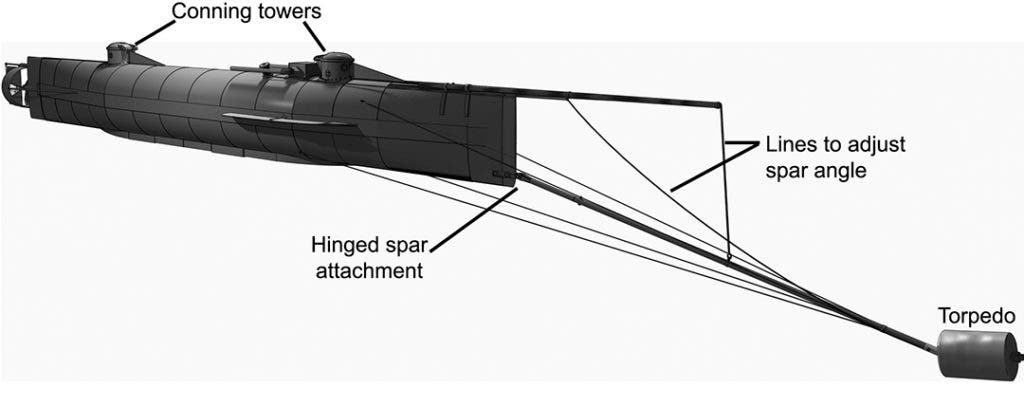
On the fateful morning of Feb. 17, 1864, a crew of eight sailors inched through the murky waters close to the Charleston’s outer harbor inside a unique and strange contraption for its time. This was not a ship but the first ever combat sub, the H.L. Hunley. It’s mission: sink the pestering 1,200-ton Union warship, the USS Housatonic, which had been blocking Charleston. With a well-placed torpedo (sort of), the Hunley achieved its mission having sunk the Housatonic in no more than five minutes after the explosion, much to the rejoicements of Confederate commanders. At the end of the day though, the Hunley was nowhere to be found.
It was only in 1995 that the 12-meter-long Hunley was recovered, found about 300 meters away from the Housatonic’s resting place. It is now undergoing study and conservation in Charleston by a team of Clemson University scientists. In the meantime, a new study performed by Rachel Lance for her Ph.D. at Duke Engineering pieces together the last moments of the Hunley and reveals the fate of its crew. According to her work, all eight sailors were killed by their own weapon or rather the blast whose shockwave damaged their internal organs, killing them instantly. Previously, most people thought the crew died of suffocation or drowning.
“The disappearance of the Hunley has long stood as one of the great mysteries of American history,” Lance said in a statement. “Finding the cause of death of the crew has finally allowed us to declare the mystery solved.”
A mystery revealed
The Hunley, sometimes called the “fish torpedo boat”, was supposedly fashioned out of a cast-off steam boiler. Each end was equipped with a ballast tank which could flooded by valves or pumped dry by hand pumps. Everything was operated by hand. Seven out of the eight sailors that were supposed to man the sub were busy turning the hand-cranked propeller while the eight steered the boat.
Few people are aware that the Hunley sunk on Feb. 17 was the third to get destroyed. On two other occasions the Hunley sunk, drowning 13 crewmen including its namesake, Horace L. Hunley, who was responsible for the combat sub’s research and development.
When the Hunley was finally found off Charleston harbor, everyone hoped they now could definitely answer how its crew died. What happened instead was the discovery raised more questions than it answered.
Besides a hole in one of the conning towers and a small broken window, the sub was very much intact despite more than a century and a half of slumber at the bottom of the water. As for the crew itself, all members were found as if they were still serving their stations along the hand-crack that propelled the sub. What’s more, their bones suffered no visible injury, suggesting their torpedo — a copper keg of gunpowder fastened on a 16-foot pole — didn’t damage the ship. The obvious explanation was that the sailors drowned after the sub took a leak, perhaps after Union sailors shot pellets at it as reported historically. But if that’s the case why didn’t the crew struggle?
To get to the bottom of things, Lance took on some serious detective work that saw her scrambling for clues in the National Archives in Washington, working closely with a dive-certified ATF agent expert in explosives or testing historically accurate sheets of iron.
For her experiment, Lance and colleagues designed and built a 6-1/2-foot mild steel scale model of the Hunley. A series of pressurized-air blasts and scaled black powder explosions were then fired near the ship at least at the torpedo’s spar length. Sensors embedded inside and outside the ship then recorded physical parameters.
Civil War forensics

What she ultimately found was that the crew was almost certainly killed by the explosive’s shockwave, which destroyed their lungs and brains but left the ship and their bones intact. This effect is known as blast-lung.
“This is the characteristic trauma of blast victims, they call it ‘blast lung,'” said Lance “You have an instant fatality that leaves no marks on the skeletal remains. Unfortunately, the soft tissues that would show us what happened have decomposed in the past hundred years.”
It was a combination of shockwaves, in fact, that caused such unspeakable damage. Because water molecules are more densely packed than air molecules, a blast wave travels far faster in water than outside its surface — about 1,500 meters per second in water versus 340 m/sec in the air (the speed of sound). When the two shockwaves meet, such as in a frothy combination like the human lungs, the energy of the blast travels slower thus amplifying the damage. According to Lance, once it crossed the lungs of the crewmen, the shockwave was slowed to about 30 m/s, subjecting the crew to 60 milliseconds or more of trauma. That’s about six times longer than they would have seen from a blast shockwave traveling in the air.
As a result of this deadly combination of effects, delicate structures where the blood supply meets the air supply get torn to shreds by shear forces, filling the lungs with blood in the process. The blast could have also triggered traumatic brain injuries, the calculations suggest.
All of this damage would have been clearly seen in the soft tissue but leave no trace in the skeleton remains. Coupled with the crew’s remains position and the relatively intact sub, Lance concludes the shockwave was the prime murderer.
“All the physical evidence points to the crew taking absolutely no action in response to a flood or loss of air,” she said.
Correction: An earlier version of this article stated water molecules are less densely packed than air, which was wrong.



